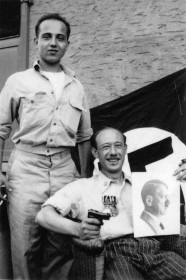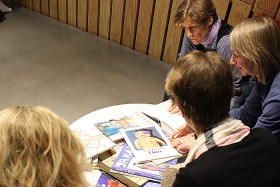Film Historian Claudia Dillmann on the Artur Brauner Film Collection in Our Library
The German film producer and Shoah survivor Artur Brauner has kindly donated to our Museum twenty-one films on the subject of the Shoah and the Nazi era—you’ll find the complete list on our website. Today, the Museum acknowledges our great appreciation of this gift with a special event in the presence of Artur Brauner and his family.

Claudia Dillmann
Photo: Deutsches Filminstitut/Uwe Dettmar
Prior to the event we interviewed film historian Claudia Dillmann about Artur Brauner and the appeal of his film productions, in particular for a Jewish Museum. Ms. Dillmann is Director of the German Film Institute in Frankfurt Main and a renowned expert on Artur Brauner, and also initiated the online resource www.filmportal.de. She talked to us about Brauner’s interest in the victims of Nazi crimes, the balancing acts it has called for, his veneration of Romy Schneider, and the German public’s tastes.
Mirjam Bitter, Blog Editor: Ms. Dillman, in your opinion, how representative is our Artur Brauner Film Collection of Mr. Brauner’s entire production list?
Claudia Dillmann: The films that Artur Brauner has donated to the Jewish Museum are indeed representative since they constitute a pivot of his career—one very dear to his heart—namely an abiding commitment to exposing the Holocaust, not least because forty-nine of his own relatives also lost their lives then. He sees these films as his personal “legacy,” one he has been forging since the start of his career. They are dedicated to victims of the Nazi regime and constitute a cycle that in his view is still not complete. In them, he has continually explored new facets of persecution under the Nazi terror and of the traumata he lived through himself. → continue reading
Program Director Cilly Kugelmann on the Exhibition “NO COMPROMISES! The Art of Boris Lurie”

“As this image of Lurie with his brother-in-law Dino Russi from 1946 shows, the NO!art artists, in reclaiming the swastika symbol, robbed it of its symbolic value.” (Cilly Kugelmann)
Boris Lurie Art Foundation, New York
Our major retrospective dedicated to Boris Lurie opens 26 February 2016 (for more information see www.jmberlin.de/lurie/en). Blog editor Mirjam Bitter spoke with Cilly Kugelmann about the artist, his provocative work, and the possible impact today of the taboos that he broke throughout his career.
Mirjam Bitter: What is your view of Boris Lurie? What sort of a guy was he? What distinguished him as an artist?
Cilly Kugelmann: The man and the artist Boris Lurie was shaped by his experience of persecution and concentration camps under the Nazi regime. And yet, unlike other artists who faced similar experiences, I feel he cannot be described as a “Holocaust artist.” With the exception of some early drawings from 1946 and a few paintings from the late 1940s, he neither chronicled these events nor sought to interpret the Holocaust artistically in his work.
Then what role did the Holocaust play in Lurie’s work? → continue reading
An Interview with Barbara Rösch about “Recommended Reading on National Socialism and the Holocaust”

Members of the reading circle © Jewish Museum Berlin, photo: Christine Marth
A German-language brochure listing “Recommended Reading on National Socialism and the Holocaust” was recently made available for download from our website as a PDF. Over the last few years several museum employees read widely on the topic, shared their opinions and then made this selection. Dr. Barbara Rösch of our Education Department talked to me about what was involved. She is a member of the reading circle and also worked for a time at the Universities of Potsdam and Leipzig as an elementary school teacher trainer. In addition to her work at the Jewish Museum Berlin she is currently writing a book about everyday racism in elementary schools.
Dear Barbara, countless books about National Socialism and the Holocaust are available for children and young people. How did you go about making a selection?
Our work is oriented primarily to the needs of teachers, who regularly ask us to make recommendations and indeed seem almost to think that we must. We therefore bear in mind the so-called “classics” that are read in German classrooms as well as new publications, books written from a non-German perspective, and books that touch upon hitherto neglected themes, such as the hakhshara movement. → continue reading


